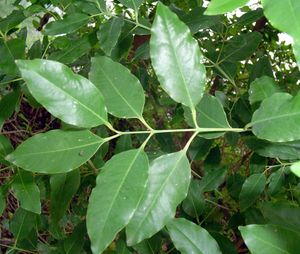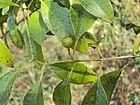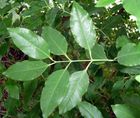Note: This is a project under development. The articles on this wiki are just being initiated and broadly incomplete. You can Help creating new pages.
Santalum album - Sandal Wood, Chandana
Sandalwood is the name of a class of woods from trees in the genus Santalum. Species of these slow-growing trees have suffered over-harvesting in the past century.
Contents
- 1 Uses
- 2 Parts Used
- 3 Chemical Composition
- 4 Common names
- 5 Properties
- 6 Habit
- 7 Identification
- 8 List of Ayurvedic medicine in which the herb is used
- 9 Where to get the saplings
- 10 Mode of Propagation
- 11 How to plant/cultivate
- 12 Commonly seen growing in areas
- 13 Photo Gallery
- 14 References
- 15 External Links
Uses
skin diseases, swelling, itching, eczemas, acne, bronchitis, fever, headache, gastric problem, chronic cough, scabies, gonorrhoea.
Parts Used
Chemical Composition
Sandal wood oil contains mixture of two isomers α and β-santolol (90%), α and β-santalene, santalone, santanone, isovaleraldehvde, α and β-santalic acids[1]
Common names
| Language | Common name |
|---|---|
| Kannada | Agarugandha, bavanna |
| Hindi | Chandan |
| Malayalam | Chandanam, chandana-mutti |
| Tamil | Anukkam, Asam |
| Telugu | Bhadrasri |
| Marathi | NA |
| Gujarathi | NA |
| Punjabi | NA |
| Kashmiri | NA |
| Sanskrit | |
| English | Sandalwood, Indian sandalwood |
Properties
Reference: Dravya - Substance, Rasa - Taste, Guna - Qualities, Veerya - Potency, Vipaka - Post-digesion effect, Karma - Pharmacological activity, Prabhava - Therepeutics.
Dravya
Rasa
Tikta (Bitter), Madhura (Sweet)
Guna
Laghu (Light), Ruksha (Dry)
Veerya
Sheeta (clod)
Vipaka
Katu (Pungent)
Karma
Kapha, Pitta
Prabhava
Habit
Identification
Leaf
| Kind | Shape | Feature |
|---|---|---|
| Simple | oval | The oval leaves are thin, oppositely arranged. Smooth surface is shiny and bright green, with a glaucous pale Underside |
Flower
| Type | Size | Color and composition | Stamen | More information |
|---|---|---|---|---|
| Unisexual | 2-4cm long | Yellow or reddish | 5 | The flowers and wood of sandalwood are harvested for the plant’s fragrant essential oil |
Fruit
| Type | Size | Mass | Appearance | Seeds | More information |
|---|---|---|---|---|---|
| Simple | 7–10 cm | Fruit is produced after three years | five | {{{6}}} |
Other features
List of Ayurvedic medicine in which the herb is used
- Vishatinduka Taila as root juice extract
Where to get the saplings
Mode of Propagation
How to plant/cultivate
If you are planning for the sandalwood tree cultivation then you may require well-drained soils which have a good organic object. The red sandy loam soils are also suitable for the sandalwood tree and you get the high yield crop.[3]
Commonly seen growing in areas
Stony hills area, Stony meadows
Photo Gallery
References
External Links
- Ayurvedic Herbs known to be helpful to treat skin diseases
- Ayurvedic Herbs known to be helpful to treat swelling
- Ayurvedic Herbs known to be helpful to treat itching
- Ayurvedic Herbs known to be helpful to treat eczemas
- Ayurvedic Herbs known to be helpful to treat acne
- Ayurvedic Herbs known to be helpful to treat bronchitis
- Ayurvedic Herbs known to be helpful to treat fever
- Ayurvedic Herbs known to be helpful to treat headache
- Ayurvedic Herbs known to be helpful to treat gastric problem
- Ayurvedic Herbs known to be helpful to treat chronic cough
- Ayurvedic Herbs known to be helpful to treat scabies
- Ayurvedic Herbs known to be helpful to treat gonorrhoea
- Herbs with Dried Folaige used in medicine
- Herbs with Whole herb used in medicine
- Herbs with common name in Kannada
- Herbs with common name in Hindi
- Herbs with common name in Malayalam
- Herbs with common name in Tamil
- Herbs with common name in Telugu
- Herbs with common name in English
- Habit - Tree
- Index of Plants which can be propagated by Seeds
- Index of Plants which can be propagated by Cuttings
- Herbs that are commonly seen in the region of Stony hills area
- Herbs that are commonly seen in the region of Stony meadows
- Herbs








